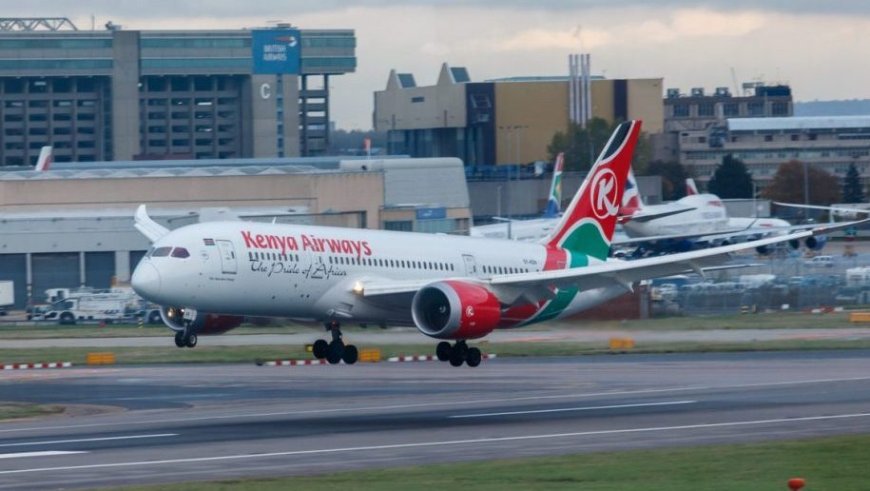What It Takes For Airlines To Add New Routes
When an airline introduces a new route, it is far from a simple case of dispatching an aircraft from Point A to Point B.

Do you believe airlines wake up and announce a new route out of the blue? Our answer for you is no. The modern world thrives on connectivity, with aviation remaining a cornerstone of global movement.
When an airline introduces a new route, it is far from a simple case of dispatching an aircraft from Point A to Point B. Instead, it represents the culmination of intricate planning, complex negotiations, in-depth data analysis, strict regulatory approvals, and extensive stakeholder collaboration.
For Kenyan travellers and business operators, understanding what goes into establishing a new airline route helps reveal the enormous work behind flights connecting Nairobi to major destinations such as Dubai, London, or Mombasa.
Market Research: Gauging Demand Before Take-Off
The initial step in route establishment lies in robust market research and demand forecasting. Airlines must carefully examine whether there is enough passenger or cargo demand to justify a sustainable service.
In Kenya, the steady growth of the middle class and an expanding diaspora community have led airlines to explore more long-haul routes to and from Europe and North America. Market demand is assessed through detailed analysis of passenger booking trends, travel agency data, and official statistics. Surveys also help airlines uncover traveller preferences and likely travel patterns.

Scenes at Jomo Kenyatta International Airport (JKIA) in Nairobi ahead of the launch of Nairobi-New York flights on October 28, 2018. /QUARTZ
Economic and trade data further strengthen demand projections by showing whether enough business or tourism links exist. For instance, Kenya Airways might explore Nairobi–Guangzhou flights based on the robust volume of traders travelling between Kenya and China. Similarly, new regional routes, such as Nairobi to Goma in the DRC, could emerge from consistent mining, humanitarian, or diplomatic traffic.
Airport Capacity: Checking the Infrastructure
Once an airline believes there is sufficient demand, the next step is to examine whether both the origin and destination airports can physically and operationally handle the proposed flights.
Nairobi’s Jomo Kenyatta International Airport (JKIA) is a regional hub, with runways long enough for wide-body jets, ample parking bays, and passenger facilities to support large traffic volumes. However, smaller airports like Kisumu or Eldoret may have restrictions on runway length, terminal space, or fueling capacity.
Airlines work closely with airport authorities to confirm runway suitability, available take-off and landing slots, and sufficient customs and baggage handling resources. If infrastructure gaps are discovered, airlines sometimes lobby for upgrades, which can take months or even years to complete.
Regulatory Approvals: Navigating Bilateral Agreements
Regulatory compliance is another major pillar of route planning. Countries negotiate bilateral air service agreements (BASAs) that define which airlines, how many flights, and what routes can operate between them.
For example, if Kenya Airways wants to launch flights to Canada, it must ensure those rights exist under a Kenya-Canada BASA. These treaties protect local carriers from unfair competition while promoting balanced market access.
In addition to bilateral approvals, airlines must comply with licensing requirements from the Kenya Civil Aviation Authority (KCAA), pass security and safety audits, and meet environmental rules on noise or emissions.
Slot allocation — the legal permission to land or take off at a certain time — is also critical, especially at busy airports. These requirements safeguard passengers and uphold Kenya’s aviation standards before any aircraft takes to the skies.
Fleet Strategy: Picking the Right Aircraft
Matching the right aircraft to the right route is fundamental for success. Kenyan airlines must ensure their planes can handle the route distance while meeting projected demand profitably.
Long-haul routes such as Nairobi–New York require large, fuel-efficient aircraft like the Boeing 787 Dreamliner. Shorter trips to destinations such as Entebbe, Uganda, are better served by mid-size aircraft like Embraer 190s or even turboprops.

A Kenya Airways plane taking off from London Heathrow Airport. /BUSINESS TRAVELLER
This balancing act involves looking at aircraft range, seating capacity, fuel efficiency, and cargo space. Failing to match the aircraft to the route can have disastrous consequences, as several Kenyan airlines learned when they overstretched their fleets on routes that ultimately could not sustain enough demand.
Revenue Management: Setting Profitable Fares
Once the aircraft is chosen and the route approved, airlines must price their services attractively yet profitably.
Revenue management teams rely on sophisticated forecasting models to anticipate seasonal demand, monitor competitor pricing, and measure travellers’ willingness to pay. For instance, fares on routes to Mombasa rise sharply during the Christmas period but soften in off-peak months like February.
Dynamic pricing also applies to new routes, ensuring airlines can recover costs while filling seats. Codeshare partnerships with other carriers can help spread financial risk and broaden market reach. In Kenya, such partnerships have proved vital for maximising returns, especially on routes with unpredictable demand.
Stakeholder Engagement: Winning Local Support
Airlines cannot operate in isolation. In Kenya, stakeholder engagement includes collaboration with the Kenya Airports Authority (KAA), the Kenya Civil Aviation Authority (KCAA), the Ministry of Transport, county governments, tourism boards, and even business chambers. These partners can promote a route, offer incentives like reduced landing fees, or help smooth out the regulatory approvals.
For example, coastal county governments have in the past supported charter flights to destinations such as Malindi or Ukunda to help grow tourism. Such alliances are essential in converting a route proposal from theory into a successful commercial venture.
Marketing and Promotions: Filling the Seats
Once approvals and operations are in place, airlines must market the route to build passenger numbers.
Marketing strategies typically include launch events, media advertising, partnerships with travel agents, and discounted inaugural fares. Social media and influencer collaborations are increasingly important, given how many Kenyans now research flights online.
Kenyan travellers prioritise safety, reliability, and affordability, so airlines must ensure their marketing campaigns resonate with these core values. Promotions during launch periods are an effective way to build an initial customer base and spark word-of-mouth growth.
Operational Readiness: Behind-the-Scenes Preparation
Bringing a new route online requires extensive operational planning. Airlines must assign pilots, cabin crew, ground staff, and customer service agents to handle the flights. These teams often undergo destination-specific training to learn about local security procedures, customs requirements, and cultural norms.
Other critical details include negotiating catering contracts, confirming fuel availability, and testing baggage handling systems at the new destination. Some Kenyan airlines even conduct trial runs to ensure check-in processes and aircraft turnaround procedures work smoothly.
Without rigorous preparation, a new route risks being derailed by operational hiccups that damage customer trust.
Cultural and Political Factors: Accounting for Realities
Cultural, social, and political factors also weigh heavily on route decisions. Kenyan travellers often prefer destinations where they have cultural familiarity, existing diaspora communities, or favourable visa regimes. Conversely, political tensions can undermine even the most promising routes.
If two governments fall out diplomatically, bilateral agreements may be suspended, grounding any planned service. Airlines in Kenya keep a close watch on geopolitics to avoid investing in routes that could be jeopardised by sudden policy shifts or security events.
Environmental Concerns: Flying Responsibly
In today’s world, sustainability is a key part of any new route discussion. Kenyan carriers increasingly face questions about their environmental credentials, especially from younger passengers concerned about climate change.

Inside the interior of an aircraft. /AIR CANADA
Airlines must calculate carbon emissions for new routes, comply with programs like the Carbon Offsetting and Reduction Scheme for International Aviation (CORSIA), and communicate their sustainability efforts to travellers.
Investments in newer, more efficient aircraft and carbon offset programs can help airlines win favour with an increasingly eco-aware audience while also reducing operating costs over time.
Kenya’s Aviation Outlook: Future Pathways
Kenya continues to solidify its position as a key African aviation hub. Nairobi’s JKIA is steadily expanding its role as an East African gateway, while airports in Kisumu, Eldoret, Malindi, and Ukunda are improving their infrastructure to welcome more flights. This sets the stage for airlines to explore fresh destinations, whether to secondary European and American cities, Asian commercial hubs, or West African capitals.
These new routes will unlock more opportunities for tourism, trade, cultural exchange, and investment — all contributing to Kenya’s economic growth and global connectivity.
Challenges and Risks: Turbulence Along the Way
Despite best efforts, launching a new route comes with real risks. High fuel prices, currency volatility, regional insecurity, health crises like pandemics, and fierce competition can all destabilise even the most carefully planned service. The COVID-19 crisis, for example, showed how fragile air travel can be in the face of sudden global shocks.
Kenyan airlines must therefore remain agile, constantly reevaluating their assumptions, and adapting to a rapidly changing operating environment.
The Economic Payoff: More Than Just Flights
When a new route takes off successfully, its positive impact ripples far beyond the airline. It creates jobs for pilots, cabin crew, mechanics, ground staff, and security teams.
It boosts tourism, stimulating hotels, restaurants, tour operators, and local communities. It also strengthens trade by giving importers and exporters faster, more reliable cargo options.
Overall, a successful route reinforces Kenya’s place in the global economy, giving the country new opportunities to grow and connect with the world.
Establishing a new airline route is an elaborate, sophisticated process that combines data analysis, logistics expertise, regulatory navigation, and strategic marketing. Kenyan airlines, supported by government and aviation stakeholders, work tirelessly behind the scenes to ensure that each route meets rigorous safety and commercial criteria before the first passenger ever boards.
So the next time you see a new flight announced out of Nairobi, Mombasa, Kisumu, or Eldoret, remember the countless hours, negotiations, and expertise that went into making it possible. Kenya’s aviation future remains bright, promising even greater global reach and economic opportunities in the years to come.






